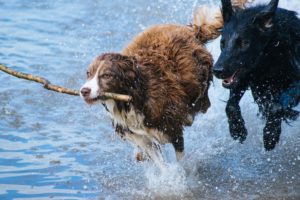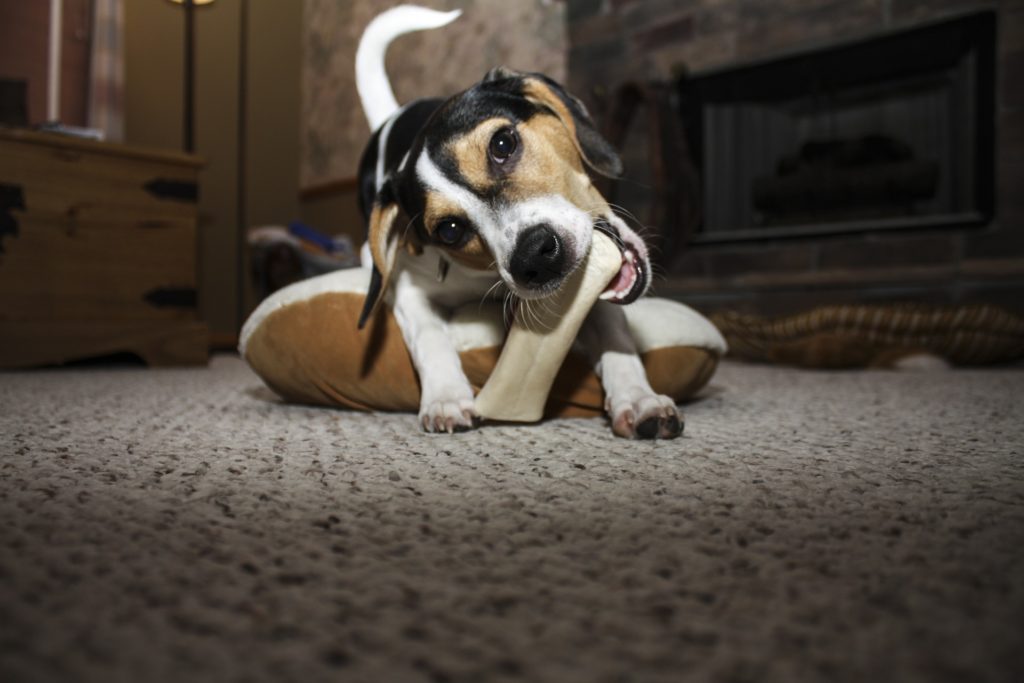Rawhide chews are a popular treat to give your dog. These tasty dog chews come in a variety of shapes, sizes, and flavors to keep your dog content and occupied. However, it’s important to note that these treats are not always safe for your four-legged companion. While your dog may be a fan of their flavor and texture, there are still a few reasons why rawhide may not be the best option. If you have ever wondered, “Are rawhide dog chews safe for pets?”, this blog post is for you. In this article, you’ll be learning about the possible risks and benefits of rawhide dog chews for canines. Once you’ve been educated with this information, you’ll be able to decide for yourself if these treats are the best option for your loving companion.
The Potential Risks of Rawhide Dog Chews
Chemicals
Rawhide is the dried inner-layer of animal skin. Most often, this animal skin comes from a cow or a horse, which is cured in salt and lime. Extra flavoring is added at the end of the curing process before it is molded and shaped. It is not uncommon for chemicals to be used during the manufacturing stage of rawhide. Just like in humans, infrequent exposure to small amounts of chemicals will not be enough to cause a long-term health issue, however, it is still highly advised to stay away from any harmful chemicals or toxins when it comes to your dog’s diet.
Bacteria
Curing rawhide usually takes a couple of weeks, and while the decaying process can be slowed down, it cannot be stopped completely. As a result, rawhide is susceptible to bacteria growth like E. Coli and Salmonella. During the curing process, the hide can be exposed to contaminants that may even linger after chemicals have been applied. If you decide to give your dog one of these treats, always remember to rinse off your rawhide chew before giving it to him!
Choking Hazard
 Choking is one of the biggest concerns when it comes to feeding your dog a rawhide chew. As the rawhide deteriorates and splinters, your dog is more likely to ingest a larger piece of the chew than he can handle. Every dog has a different style of chewing, so it is important to monitor how your dog is breaking down the chew. While it is meant to be edible and safe for consumption, it’s better to err on the side of caution and take the larger splintered chunks away from your dog to prevent a possible choking hazard. If your dog is choking, the best way to help him is to take a look inside and try to clear the obstruction from his airways. Once your dog is in stable condition, take him to the vet for further examination.
Choking is one of the biggest concerns when it comes to feeding your dog a rawhide chew. As the rawhide deteriorates and splinters, your dog is more likely to ingest a larger piece of the chew than he can handle. Every dog has a different style of chewing, so it is important to monitor how your dog is breaking down the chew. While it is meant to be edible and safe for consumption, it’s better to err on the side of caution and take the larger splintered chunks away from your dog to prevent a possible choking hazard. If your dog is choking, the best way to help him is to take a look inside and try to clear the obstruction from his airways. Once your dog is in stable condition, take him to the vet for further examination.
Intestinal Blockages
Even if your dog manages to swallow a large chunk of rawhide without issue, there is still the risk of an intestinal blockage. Although rawhide is meant to be digestible, sometimes large obstructions need to be removed surgically and could lead to higher health risk if not dealt with in a timely fashion.
Allergies and Indigestion
Rawhide does have the potential to upset your dog’s stomach. There is no telling what might disagree with your dog’s internal system. Dogs can develop allergies or a sensitivity to these products, making it imperative that you closely watch him any time you feed him a new food. In some cases, a dog may develop an upset stomach, vomiting, regurgitation, or diarrhea.
How Rawhide Chews Can Benefit Your Dog
Jaw exercise
 Rawhide, along with other types of chews, are great for keeping your dog’s mouth healthy. Chewing, and more specifically gnawing, helps keep the muscles in a dog’s jaw strong. Depending on the shape and strength of the chew you choose, a rawhide can be a good way for your dog to exercise his chewing habit. Frozen carrot sticks are a great natural alternative to rawhide for some dogs that like to chew as well. Even rubber toys can be good for bigger dogs with stronger jaw muscles like a Labrador Retriever or a Pit Bull.
Rawhide, along with other types of chews, are great for keeping your dog’s mouth healthy. Chewing, and more specifically gnawing, helps keep the muscles in a dog’s jaw strong. Depending on the shape and strength of the chew you choose, a rawhide can be a good way for your dog to exercise his chewing habit. Frozen carrot sticks are a great natural alternative to rawhide for some dogs that like to chew as well. Even rubber toys can be good for bigger dogs with stronger jaw muscles like a Labrador Retriever or a Pit Bull.
Clean Teeth and Fresh Breath
Rawhide can be a good way to keep a dog’s teeth clean. A dog will typically use his whole mouth to bite and gnaw on the rawhide chew. This action allows your dog to scrape off any excess food residue or plaque that may be lingering on his teeth. As a bonus, less food residue and tartar means fresh breath for your dog!
Chewing is an integral part of your dog’s healthy habits. Along with reducing tartar buildup and keeping the jaw healthy and strong, chewing is a great stress reliever for your dog. It is important to remember that no amount of chewing is a substitute for brushing your dog’s teeth. Dental hygiene is vital for your dog to prevent canine gum disease and chewing is only a small piece of what should be a larger dental routine.
When experimenting with rawhide, it is crucial to monitor your dog and be aware of the associated risks. Rawhide might be good for a special treat, but there is a whole big world of chew toys and treats to give your dog.
Sources:
“Rawhide Bones and Treats for Dogs: Risks and Benefits.” WebMD, pets.webmd.com/dogs/rawhide-good-or-bad-for-your-dog.
“Why Rawhide Is Dangerous For Your Dog!” Dogs Naturally, 10 Jan. 2019, www.dogsnaturallymagazine.com/rawhide-dangerous-for-dogs/.
Becker, Marty. “Is It Safe to Give My Dog a Rawhide?” Vetstreet, www.vetstreet.com/dr-marty-becker/is-it-safe-to-give-my-dog-a-rawhide.




